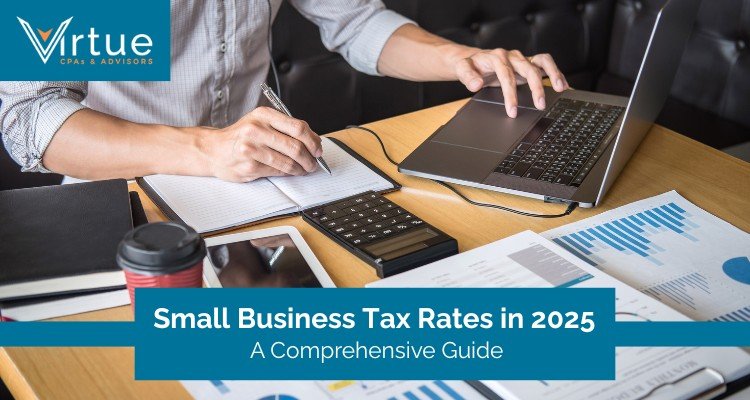Navigating small business tax rates in 2025 has become increasingly complex, with federal changes, state variations, and expiring deductions creating both challenges and opportunities for law firms and professional service businesses.
The difference between paying 21% and 50% in effective tax rates often comes down to strategic business structure decisions and proactive tax planning. With the valuable Qualified Business Income deduction set to expire at the end of 2025, this year presents a critical window for tax optimization strategies.
Understanding these rates and implementing the right approach can save your practice tens of thousands of dollars annually while ensuring full compliance across all jurisdictions.
What Are Small Business Tax Rates in 2025?
Small business tax rates in 2025 range from 10%-37% for pass-through entities and 21% for C-Corporations at the federal level, plus varying state rates from 0%-13.30%.
Tax season 2025 brings updated rates and new opportunities for significant savings. Understanding your exact tax rate can save thousands of dollars in liability for law firms and professional service businesses.
Your tax rate depends entirely on your business structure. The 2025 updates include inflation-adjusted brackets and higher standard deductions that could reduce your overall tax burden.
How Do Federal Tax Rates Vary by Business Structure?
1. What Is the Tax Rate for C-Corporations?
C-Corporations pay a flat 21% federal tax rate on all taxable income in 2025.
This rate remains unchanged from 2024, providing predictability for larger law firms considering corporate structures. However, C-Corp profits face double taxation when distributed to shareholders as dividends.
For example, a law firm with $500,000 in taxable income pays $105,000 in federal corporate taxes. If owners take $200,000 in dividends, they'll pay additional personal taxes on those distributions.
The C-Corp structure makes sense for firms planning to retain significant earnings for expansion or equipment purchases.
Contact our Entity Formation specialists for personalized guidance.
2. What Tax Rate Do LLCs Pay in 2025?
LLCs pay 10%-37% based on the owner's personal income tax bracket, unless elected corporate taxation.
Most law firm LLCs use pass-through taxation, meaning profits flow to partners' personal returns. This avoids double taxation but subjects all earnings to self-employment tax.
Self-employment tax adds 15.3% on net earnings up to $160,200, plus 0.9% Medicare tax for high earners over $200,000 (single) or $250,000 (married filing jointly).
3. What Is S-Corporation Tax Rates for 2025?
S-Corporations use pass-through taxation (10%-37%) but can significantly reduce self-employment taxes through strategic salary and distribution planning.
S-Corp owners must pay themselves a reasonable salary subject to payroll taxes. Remaining profits can be distributed without self-employment tax, creating substantial savings.
For instance, a solo practitioner earning $200,000 might pay $60,000 as salary and take $140,000 as distributions, potentially saving over $10,000 annually in self-employment taxes.
The QBI deduction also benefits S-Corp owners, potentially reducing taxable income by 20% - but this expires December 31, 2025.
2025 Federal Tax Brackets for Pass-Through Entities
| Tax Rate | Single Filers | Married Filing Jointly |
|---|---|---|
| 10% | $0 - $11,925 | $0 - $23,850 |
| 12% | $11,926 - $48,475 | $23,851 - $96,950 |
| 22% | $48,476 - $103,350 | $96,951 - $206,700 |
| 24% | $103,351 - $197,300 | $206,701 - $394,600 |
| 32% | $197,301 - $250,525 | $394,601 - $501,050 |
| 35% | $250,526 - $626,350 | $501,051 - $626,350 |
| 37% | $626,351+ | $626,351+ |
Source: 2025 Tax Brackets
How Do State and Local Taxes Affect Small Business Tax Rates?
State tax rates range from 0% (Texas, Florida) to 13.30% (California), significantly impacting your total tax liability.
Corporate rates vary from 0% to 11.5%, while personal rates for pass-through entities range from 13.30%. Eight states impose no income tax: Alaska, Florida, Nevada, South Dakota, Tennessee, Texas, Washington, and Wyoming.
Georgia law firms benefit from moderate rates: 5.75% corporate and 5.49% personal income tax. Our State & Local Tax Compliance services help navigate multi-state obligations for practices with operations across state lines.
Multi-state practices must handle complex apportionment rules and economic nexus requirements that can trigger tax obligations in multiple jurisdictions.
What Additional Tax Obligations Do Small Businesses Face?
1. What Are Payroll Tax Rates for Small Businesses?
Payroll taxes total 15.3% (split between employer and employee) for FICA, plus federal and state unemployment taxes.
The breakdown includes:
- Social Security: 12.4% on wages up to $160,200
- Medicare: 2.9% on all wages
- Additional Medicare: 0.9% over income thresholds
- FUTA: 6% (reduced to 0.6% with credits) on first $7,000 per employee
Our Payroll Services ensure accurate calculations and timely compliance for law firms with employees.
2. What Is the Self-Employment Tax Rate for 2025?
Self-employment tax is 15.3% on net earnings up to $160,200, plus 2.9% Medicare tax on all earnings.
Solo practitioners and LLC members pay the full 15.3% rate. However, you can deduct half of the self-employment tax paid, slightly reducing the effective burden.
How Do You Calculate Your Small Business Tax Rate?
Real-World Example: $200,000 Law Firm LLC
Calculate by determining taxable income, applying the appropriate rate, adding self-employment tax, and including state obligations.
For a single-member LLC with $200,000 net income:
- Federal income tax (24% bracket): ~$32,748
- Self-employment tax: ~$24,480
- Georgia state tax (5.49%): $10,980
- Total effective rate: ~34.1%
Electing S-Corp taxation could reduce this burden by $3,000-$5,000 annually through self-employment tax savings.
Need a detailed tax projection? Our CFO services offer expert tax planning customized to your business.
What Tax Planning Strategies Reduce Your Effective Rate?
1. What Business Deductions Maximize Tax Savings?
High-impact deductions include Section 179 equipment purchases, home office expenses, professional development, and technology investments.
Key deductions for law firms:
- Section 179 deduction: Up to $1,220,000 for equipment purchases in 2025
- Professional services: Continuing education, bar dues, subscriptions
- Technology expenses: Legal software, case management systems
- Vehicle expenses: Client visits and court appearances
2. How Does the QBI Deduction Work in 2025?
The QBI deduction provides up to 20% deduction on qualified business income, with phase-outs starting at $197,300 (single) or $394,600 (married filing jointly).
This valuable deduction expires December 31, 2025, unless Congress extends it. For a law firm earning $150,000, the QBI deduction could reduce taxable income by $30,000, saving $6,600-$11,100 depending on the bracket.
Strategic timing of income and expenses in 2025 becomes critical given the deduction's impending expiration.
What Are the 2025 Small Business Tax Deadlines?
Quarterly estimated payments for 2025 are due April 15, June 16, September 15, and January 15, 2026.
Important annual deadlines:
- January 31, 2025: W-2 and 1099 forms to recipients
- March 15, 2025: S-Corp and Partnership returns (Forms 1120S, 1065)
- April 15, 2025: Individual and C-Corp returns (Forms 1040, 1120)
Extensions provide additional filing time but don't extend payment deadlines. Interest and penalties accrue on unpaid balances from the original due date.
When Should You Hire a Tax Professional?
Professional guidance becomes essential for multi-state operations, annual revenue exceeding $500,000, multiple entities, or employee management.
Consider professional help when facing:
- Multi-state business operations and nexus issues
- Multiple business entities or investment structures
- Significant equipment purchases requiring depreciation planning
- Employee management and payroll tax obligations
Virtue CPAs provides year-round tax planning integrated with bookkeeping and strategic business consulting for Georgia law firms. Our comprehensive approach includes proactive planning, business structure optimization, and multi-jurisdictional expertise.
Frequently Asked Questions







